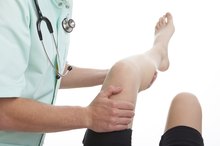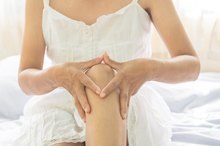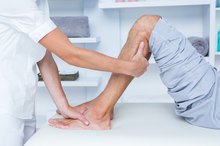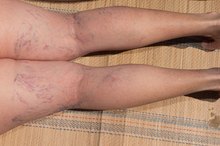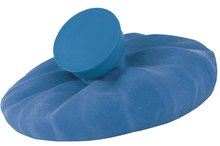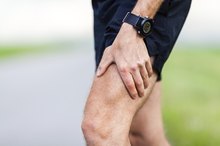Diseases That Cause Calf Muscle Pain
There are many diseases that can cause calf muscle pain. According to the U.S. National Library of Medicine and the National Institutes of Health, leg pain, including calf pain, is a common symptom and complaint, and it can be caused by numerous factors, including dehydration, medications, traumatic injury, fractures and certain medical conditions 13. Calf muscle pain can range from mild to severe, and it can signal a serious underlying medical condition.
If you are experiencing serious medical symptoms, seek emergency treatment immediately.
Intermittent Claudication
Intermittent claudication is a disease that can cause calf muscle pain. According to the University of Maryland Medical Center, intermittent claudication is a crampy leg or calf pain that occurs during physical exertion or exercise and then disappears with rest, and the pain is caused by a reduction in arterial blood flow—due to blockage of the arteries—to the lower extremity. The UMMC states that intermittent claudication is associated with peripheral artery disease, or PAD, and that about one in three people with PAD experience intermittent claudication. Common symptoms associated with intermittent claudication include the following: pain, achiness, fatigue or nonspecific discomfort in the calf muscles during exercise. According to the UMMC, the popliteal artery—located behind the knee—is the most commonly affected artery, and intermittent claudication symptoms, therefore, are most common in the calf muscles.
- Intermittent claudication is a disease that can cause calf muscle pain.
- According to the University of Maryland Medical Center, intermittent claudication is a crampy leg or calf pain that occurs during physical exertion or exercise and then disappears with rest, and the pain is caused by a reduction in arterial blood flow—due to blockage of the arteries—to the lower extremity.
Deep Vein Thrombosis
Causes of Leg & Arm Pain
Learn More
Deep vein thrombosis is a disease that can cause calf muscle pain. According to the NHLBI, the majority of deep vein blood clots occur in the lower leg or thigh, although they can occur in other locations throughout a person's body too. The NIH states that blood clots can block or occlude blood flow to the calf muscles and cause swelling and pain in the lower leg and that risk factors for DVT and blood clot formation include the following: catheter insertion in the groin; bed rest; tobacco consumption; pelvis or leg fractures; giving birth within the past six months; heart failure; certain medications; obesity; recent surgery; and certain medical conditions, such as polycythemia vera, in which a person's blood becomes too thick and slow.
Cellulitis
Cellulitis is a disease that can cause calf muscle pain 4. According to the Mayo Clinic website, cellulitis is a common and sometimes serious bacterial skin infection characterized by diffuse inflammation of a person's connective tissue 4. Cellulitis manifests as a swollen, red patch of skin that's warm and tender to the touch, and it can spread rapidly if left unchecked 4. The Mayo Clinic website states that skin on the lower legs—especially the calf—is one of the most common locations for infection, although cellulitis can occur anywhere on a person's body, including the face, and that cellulitis can affect tissues of varying depth, such as the skin or the tissues underlying the skin 4.cause:
- The Mayo Clinic website states that skin on the lower legs—especially the calf—is one of the most common locations for infection
- although cellulitis can occur anywhere on a person's body
- including the face,
- that cellulitis can affect tissues of varying depth
- such as the skin or the tissues underlying the skin 4
Without medical intervention, cellulitis can spread to a person's lymph nodes and bloodstream, which can be a potentially life-threatening situation 4. According to the Mayo Clinic website, some of the most common causes of cellulitis include streptococcus and staphylococcus infection following surgery, puncture wounds, or certain types of insect or spider bites 4.
Related Articles
References
- National Institutes of Health: Leg Pain
- National Heart, Lung and Blood Institute: Deep Vein Thrombosis
- National Institutes of Health: Deep Venous Thrombosis
- Mayo Clinic: Cellulitis
- Raff AB, Kroshinsky D. Cellulitis: A review. JAMA. 2016;316(3):325-37. doi:10.1001/jama.2016.8825
- Brown BD, Hood Watson KL. Cellulitis. [Updated 2019 Nov 6]. In: StatPearls [Internet]. Treasure Island (FL): StatPearls Publishing; 2019 Jan-.
- Gunderson CG, Martinello RA. A systematic review of bacteremias in cellulitis and erysipelas. J Infect. 2012;64(2):148055. doi: 10.1016/j.jinf.2011.11.004.
- Elahi M, Sanchez PJ, Alqudah E, Antonara S. Invasive Haemophilus influenzae infections in children: A 10-year study. Open Forum Infect Dis. 2018;5(Suppl 1):S687. doi:10.1093/ofid/ofy210.1967
- Sullivan T, de Barra E. Diagnosis and management of cellulitis. Clin Med (Lond). 2018;18(2):160–163. doi:10.7861/clinmedicine.18-2-160
- American Academy of Dermatology. Cellulitis. 2018.
- Gunderson CG, Martinello RA. A systematic review of bacteremias in cellulitis and erysipelas. J Infect. 2012 Feb;64(2):148055. doi: 10.1016/j.jinf.2011.11.004.
- Habif, T. Bacterial Infections. Clinical Dermatology, 4th Edition. New York: Mosby, 2004: 236-262.
- Halpern, A., and Heymann. W. Bacterial Diseases. Dermatology. 2nd Edition. New York: Mosby, 2008: 1075-1084.
- Morris JG. Vibrio vulnificus infections. Calderwood SB, ed. UpToDate. Waltham, MA: UpToDate Inc.
Writer Bio
Martin Hughes is a chiropractic physician, health writer and the co-owner of a website devoted to natural footgear. He writes about health, fitness, diet and lifestyle. Hughes earned his Bachelor of Science in kinesiology at the University of Waterloo and his doctoral degree from Western States Chiropractic College in Portland, Ore.

